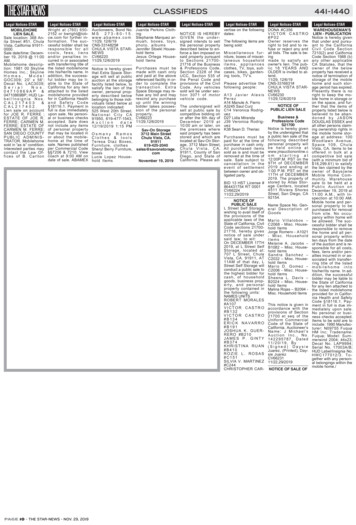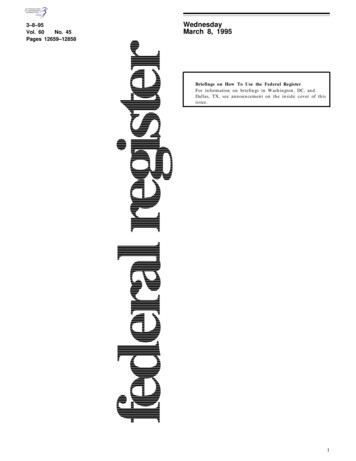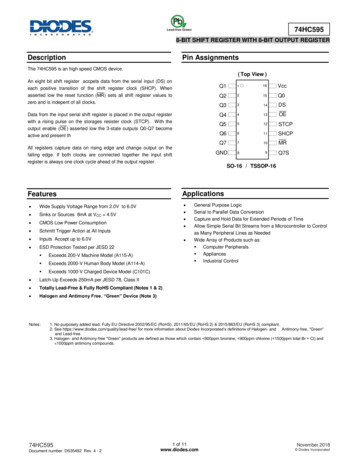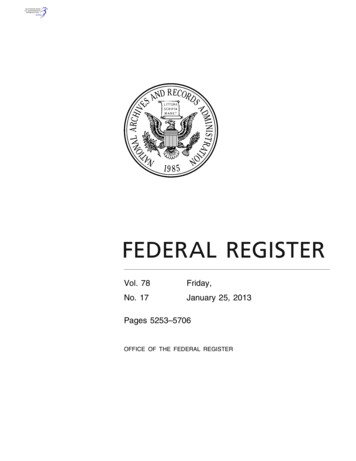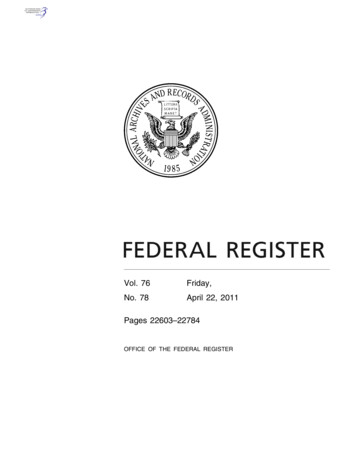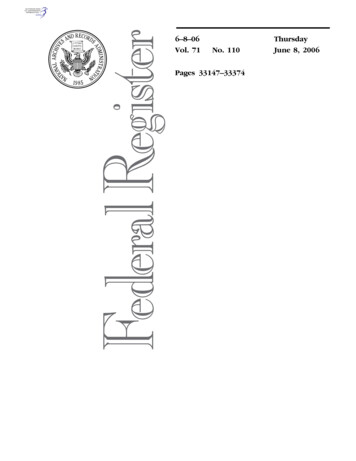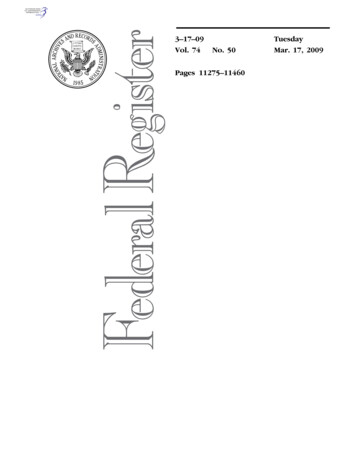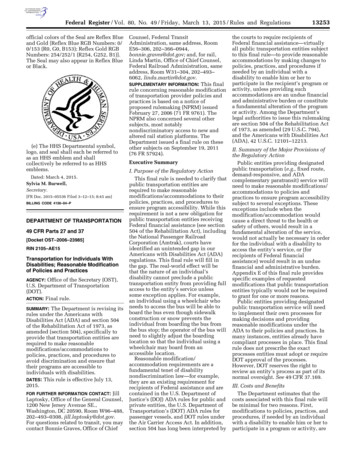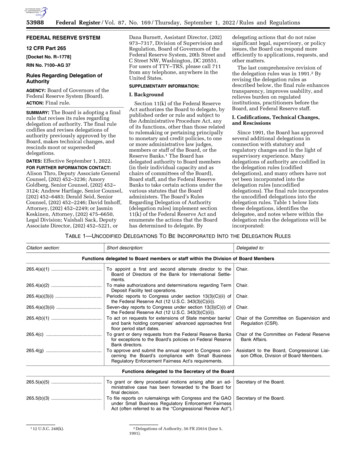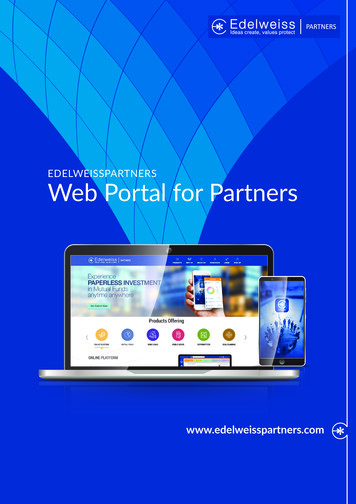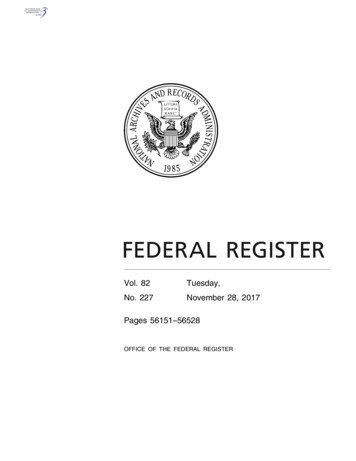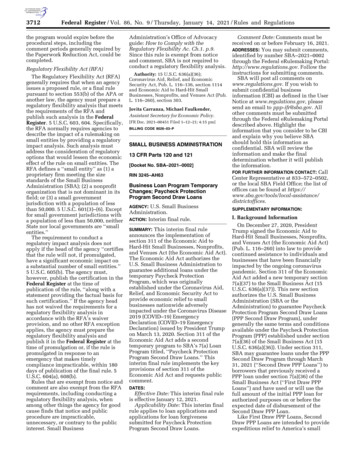
Transcription
3712Federal Register / Vol. 86, No. 9 / Thursday, January 14, 2021 / Rules and Regulationskhammond on DSKJM1Z7X2PROD with RULES6the program would expire before theprocedural steps, including thecomment periods generally required bythe Paperwork Reduction Act, could becompleted.Regulatory Flexibility Act (RFA)The Regulatory Flexibility Act (RFA)generally requires that when an agencyissues a proposed rule, or a final rulepursuant to section 553(b) of the APA oranother law, the agency must prepare aregulatory flexibility analysis that meetsthe requirements of the RFA andpublish such analysis in the FederalRegister. 5 U.S.C. 603, 604. Specifically,the RFA normally requires agencies todescribe the impact of a rulemaking onsmall entities by providing a regulatoryimpact analysis. Such analysis mustaddress the consideration of regulatoryoptions that would lessen the economiceffect of the rule on small entities. TheRFA defines a ‘‘small entity’’ as (1) aproprietary firm meeting the sizestandards of the Small BusinessAdministration (SBA); (2) a nonprofitorganization that is not dominant in itsfield; or (3) a small governmentjurisdiction with a population of lessthan 50,000. 5 U.S.C. 601(3)–(6). Exceptfor small government jurisdictions witha population of less than 50,000, neitherState nor local governments are ‘‘smallentities.’’The requirement to conduct aregulatory impact analysis does notapply if the head of the agency ‘‘certifiesthat the rule will not, if promulgated,have a significant economic impact ona substantial number of small entities.’’5 U.S.C. 605(b). The agency must,however, publish the certification in theFederal Register at the time ofpublication of the rule, ‘‘along with astatement providing the factual basis forsuch certification.’’ If the agency headhas not waived the requirements for aregulatory flexibility analysis inaccordance with the RFA’s waiverprovision, and no other RFA exceptionapplies, the agency must prepare theregulatory flexibility analysis andpublish it in the Federal Register at thetime of promulgation or, if the rule ispromulgated in response to anemergency that makes timelycompliance impracticable, within 180days of publication of the final rule. 5U.S.C. 604(a), 608(b).Rules that are exempt from notice andcomment are also exempt from the RFArequirements, including conducting aregulatory flexibility analysis, whenamong other things the agency for goodcause finds that notice and publicprocedure are impracticable,unnecessary, or contrary to the publicinterest. Small BusinessVerDate Sep 11 201400:10 Jan 14, 2021Jkt 253001Administration’s Office of Advocacyguide: How to Comply with theRegulatory Flexibility Ac. Ch.1. p.9.Since this rule is exempt from noticeand comment, SBA is not required toconduct a regulatory flexibility analysis.Authority: 15 U.S.C. 636(a)(36);Coronavirus Aid, Relief, and EconomicSecurity Act, Pub. L. 116–136, section 1114and Economic Aid to Hard-Hit SmallBusinesses, Nonprofits, and Venues Act (Pub.L. 116–260), section 303.Jovita Carranza, Michael Faulkender,Assistant Secretary for Economic Policy.[FR Doc. 2021–00451 Filed 1–12–21; 4:15 pm]BILLING CODE 8026–03–PSMALL BUSINESS ADMINISTRATION13 CFR Parts 120 and 121[Docket No. SBA–2021–0002]RIN 3245–AH63Business Loan Program TemporaryChanges; Paycheck ProtectionProgram Second Draw LoansU.S. Small BusinessAdministration.ACTION: Interim final rule.AGENCY:This interim final ruleannounces the implementation ofsection 311 of the Economic Aid toHard-Hit Small Businesses, Nonprofits,and Venues Act (the Economic Aid Act).The Economic Aid Act authorizes theU.S. Small Business Administration toguarantee additional loans under thetemporary Paycheck ProtectionProgram, which was originallyestablished under the Coronavirus Aid,Relief, and Economic Security Act toprovide economic relief to smallbusinesses nationwide adverselyimpacted under the Coronavirus Disease2019 (COVID–19) EmergencyDeclaration (COVID–19 EmergencyDeclaration) issued by President Trumpon March 13, 2020. Section 311 of theEconomic Aid Act adds a secondtemporary program to SBA’s 7(a) LoanProgram titled, ‘‘Paycheck ProtectionProgram Second Draw Loans.’’ Thisinterim final rule implements the keyprovisions of section 311 of theEconomic Aid Act and requests publiccomment.DATES:Effective Date: This interim final ruleis effective January 12, 2021.Applicability Date: This interim finalrule applies to loan applications andapplications for loan forgivenesssubmitted for Paycheck ProtectionProgram Second Draw Loans.SUMMARY:PO 00000Frm 00022Fmt 4701Sfmt 4700Comment Date: Comments must bereceived on or before February 16, 2021.ADDRESSES: You may submit comments,identified by number SBA–2021–0002through the Federal eRulemaking Portal:http://www.regulations.gov. Follow theinstructions for submitting comments.SBA will post all comments onwww.regulations.gov. If you wish tosubmit confidential businessinformation (CBI) as defined in the UserNotice at www.regulations.gov, pleasesend an email to ppp-ifr@sba.gov. Allother comments must be submittedthrough the Federal eRulemaking Portaldescribed above. Highlight theinformation that you consider to be CBIand explain why you believe SBAshould hold this information asconfidential. SBA will review theinformation and make the finaldetermination whether it will publishthe information.FOR FURTHER INFORMATION CONTACT: CallCenter Representative at 833–572–0502,or the local SBA Field Office; the list ofoffices can be found at toffices.SUPPLEMENTARY INFORMATION:I. Background InformationOn December 27, 2020, PresidentTrump signed the Economic Aid toHard-Hit Small Businesses, Nonprofits,and Venues Act (the Economic Aid Act)(Pub. L. 116–260) into law to providecontinued assistance to individuals andbusinesses that have been financiallyimpacted by the ongoing coronaviruspandemic. Section 311 of the EconomicAid Act added a new temporary section7(a)(37) to the Small Business Act (15U.S.C. 636(a)(37)). This new sectionauthorizes the U.S. Small BusinessAdministration (SBA or theAdministration) to guarantee PaycheckProtection Program Second Draw Loans(PPP Second Draw Program), undergenerally the same terms and conditionsavailable under the Paycheck ProtectionProgram (PPP) established under section7(a)(36) of the Small Business Act (15U.S.C. 636(a)(36)). Under section 311,SBA may guarantee loans under the PPPSecond Draw Program through March31, 2021 (‘‘Second Draw PPP Loans’’) toborrowers that previously received aPPP loan under section 7(a)(36) of theSmall Business Act (‘‘First Draw PPPLoans’’) and have used or will use thefull amount of the initial PPP loan forauthorized purposes on or before theexpected date of disbursement of theSecond Draw PPP Loan.Like First Draw PPP Loans, SecondDraw PPP Loans are intended to provideexpeditious relief to America’s smallE:\FR\FM\14JAR6.SGM14JAR6
Federal Register / Vol. 86, No. 9 / Thursday, January 14, 2021 / Rules and Regulationsbusinesses. Second Draw PPP Loansgenerally are guaranteed by SBA underthe same terms, conditions, andprocesses as First Draw PPP Loans. SBAguarantees 100 percent of Second DrawPPP Loans and SBA may forgive up tothe full principal loan amount. SecondDraw PPP Loans are subject to SBA’sand the Department of the Treasury’s(Treasury’s) consolidated interim finalrules implementing updates to thePaycheck Protection Program for FirstDraw PPP Loans (‘‘Consolidated FirstDraw PPP IFR’’) issued concurrentlywith this interim final rule (IFR) 1 andall PPP loan program requirements,except as specified in this IFR. The keydifferences between First Draw PPPLoans and Second Draw PPP Loans aredescribed in this IFR, which explainsthe loan terms, eligibility requirements,and application process for SecondDraw PPP Loans.khammond on DSKJM1Z7X2PROD with RULES6II. Comments and Immediate EffectiveDateThis interim final rule is being issuedwithout advance notice and publiccomment because section 303 of theEconomic Aid Act authorizes SBA toissue regulations to implement theEconomic Aid Act without regard tonotice requirements. In addition, thisrule is being issued to allow forimmediate implementation of thisprogram. The intent of the EconomicAid Act is that SBA provide relief toAmerica’s small businessesexpeditiously. The last day to apply forand receive a PPP loan is March 31,2021. Given the short duration of thisprogram, and the urgent need to issueloans quickly, the Administrator inconsultation with the Secretary hasdetermined that it is impractical and notin the public interest to provide a 30day delayed effective date. Animmediate effective date will give smallbusinesses the maximum amount oftime to apply for loans and lenders themaximum amount of time to processapplications before the program ends.This good cause justification alsosupports waiver of the 60-day delayedeffective date for major rules under theCongressional Review Act at 5 U.S.C.808(2). Although this IFR is effectiveimmediately, comments are solicitedfrom interested members of the publicon all aspects of the interim final rule.1 The Consolidated First Draw PPP IFR titled‘‘Business Loan Program Temporary Changes:Extension of and Changes to Paycheck ProtectionProgram’’ restates existing regulatory provisions toprovide lenders and new PPP borrowers a singleregulation to consult on borrower eligibility, lendereligibility, and loan application and originationrequirements issues for new First Draw PPP loans,as well as general rules relating to First Draw PPPLoan increases and loan forgiveness.VerDate Sep 11 201400:10 Jan 14, 2021Jkt 253001These comments must be submitted onor before February 16, 2021. SBA willconsider these comments and the needfor making any revisions as a result ofthese comments.III. Summary of Key Terms of PPPSecond Draw LoansThe rules applicable to Second DrawPPP Loans are published in section IVof this IFR. This summary providesadditional information and explains thekey terms in the IFR. All references tosubsections refer to section IV.Second Draw PPP Loans are generallysubject to the same terms, conditionsand requirements as First Draw PPPLoans. These include, but are notlimited to the following terms: The guarantee percentage is 100percent. No collateral will be required. No personal guarantees will berequired. The interest rate will be 100 basispoints or one percent, calculated on anon-compounding, non-adjustablebasis.2 The maturity is five years. All loans will be processed by alllenders under delegated authority andlenders will be permitted to rely oncertifications of the borrower todetermine the borrower’s eligibility anduse of loan proceeds.Subsection (b) of this IFR confirmsthat these terms apply to Second DrawPPP Loans. Subsection (b) also confirmsthat SBA’s Consolidated First Draw PPPIFR, Frequently Asked Questions(FAQs), and other guidance about PPPloans under section 7(a)(36) of the SmallBusiness Act (15 U.S.C. 636(a)(36))apply to Second Draw PPP Loans,except as specified in this IFR.3The Economic Aid Act includes termsand conditions, including but notlimited to terms relating to eligibilityand a borrower’s maximum loanamount, that apply only to Second DrawPPP Loans and do not apply to FirstDraw PPP Loans, regardless of when theFirst Draw PPP Loan is made. Theseterms and conditions specific to SecondDraw PPP Loans are summarized below.A. Eligibility Requirements1. General Eligibility RequirementsIn general, the Economic Aid Actmade the eligibility requirements forSecond Draw PPP Loans narrower thanthe eligibility requirements for FirstDraw PPP Loans. The Economic Aid Act2 Section 339 of the Economic Aid Act added‘‘calculated on a non-compounding, non-adjustablebasis’’ to the maximum interest rate for a PPP loan.3 SBA will be revising the FAQs to conform to theEconomic Aid Act as quickly as feasible.PO 00000Frm 00023Fmt 4701Sfmt 47003713generally provides that a borrower iseligible for a Second Draw PPP Loanonly if it has 300 or fewer employeesand experienced a revenue reduction in2020 relative to 2019 (described furtherbelow).4 In addition, the Economic AidAct provides that a Second Draw PPPLoan may only be made to an eligibleborrower that (i) has received a FirstDraw PPP Loan, and (ii) has used, orwill use, the full amount of the FirstDraw PPP Loan on or before theexpected date on which the SecondDraw PPP Loan is disbursed to theborrower.5 Accordingly, subsections(c)(1)(i) through (c)(1)(iv) of this IFRimplement these criteria. Subsection(c)(1)(ii) of the IFR clarifies that ‘‘the fullamount’’ of the borrower’s First DrawPPP Loan includes the amount of anyincrease on such First Draw PPP Loanmade pursuant to the Economic AidAct. In addition, subsection (c)(1)(ii) ofthe IFR clarifies that the borrower musthave spent the full amount of its FirstDraw PPP Loan on eligible expensesunder the PPP rules to be eligible for aSecond Draw PPP Loan. Thisclarification will help ensure programintegrity by preventing a borrower fromreceiving a Second Draw PPP Loan ifthe borrower has not complied with PPPloan program requirements.62. Revenue Reduction RequirementThe Economic Aid Act provides that,to be eligible for a Second Draw PPPLoan, the borrower must haveexperienced a revenue reduction of 25%or greater in 2020 relative to 2019.7 Aborrower must calculate this revenuereduction by comparing the borrower’squarterly gross receipts for one quarterin 2020 with the borrower’s grossreceipts for the corresponding quarter of2019. For example, a borrower withgross receipts of 50,000 in the secondquarter of 2019 and gross receipts of 30,000 in the second quarter of 2020has experienced a revenue reduction of40 percent between the quarters, and istherefore eligible for a Second Draw PPPloan (assuming all other eligibilitycriteria are met). Subsection (c)(1)(iv)(A)of the IFR reflects this methodology.Subsection (c)(1)(iv)(B) of the IFRprovides that a borrower that was inoperation in all four quarters of 2019 isdeemed to have experienced therequired revenue reduction if it4 See paragraph 7(a)(37)(A)(iv) of the SmallBusiness Act.5 See paragraph 7(a)(37)(O) of the Small BusinessAct.6 Subsection (B)(11) of the Consolidated FirstDraw PPP IFR specifies that the proceeds of a PPPloan may be spent only on certain eligible expenses.7 See paragraph 7(a)(37)(A)(iv) of the SmallBusiness Act.E:\FR\FM\14JAR6.SGM14JAR6
3714Federal Register / Vol. 86, No. 9 / Thursday, January 14, 2021 / Rules and Regulationskhammond on DSKJM1Z7X2PROD with RULES6experienced a reduction in annualreceipts of 25 percent or greater in 2020compared to 2019 and the borrowersubmits copies of its annual tax formssubstantiating the revenue decline. Thisprovision will allow a borrower toprovide annual tax return forms tosubstantiate its revenue reduction. TheAdministrator, in consultation with theSecretary of the Treasury (Secretary),has determined that this is necessary toimprove administrability of SecondDraw PPP Loans by providing borrowersan additional verifiable method forsubstantiating their revenue reduction.This method will be particularlyimportant for small borrowers that maynot have quarterly revenue informationreadily available. Moreover, thisapproach is appropriate because, ifannual filings show a 25 percentrevenue reduction, then at least onequarter in 2020 would have had at leasta 25 percent revenue reduction. Aborrower that did not experience a 25percent annual decline in revenues, orthat was not in operation in all fourquarters of 2019, may still meet therevenue reduction requirement underone of the quarterly measurementsdescribed above.The Economic Aid Act does notinclude a general definition of grossreceipts for purposes of determining aborrower’s revenue reduction.8Subsection (c)(2) of the IFR definesgross receipts consistent with thedefinition of receipts in 13 CFR 121.104of SBA’s size regulations because thisdefinition appropriately captures thetype of income that is typically includedin a small business’s gross receipts.98 For an eligible nonprofit organization, a veteransorganization, an eligible nonprofit newsorganization, eligible 501(c) organization, or eligibledestination marketing organization, gross receiptshas the meaning in section 6033 of the InternalRevenue Code of 1986. See paragraph 7(a)(37)(I)(ii)of the Small Business Act. Subsection (c)(2) of theIFR clarifies that this definition, which generallyrelates to eligible nonprofit organizations, appliesonly to eligible nonprofit news organizations ratherthan to all eligible news organizations.9 Subsection (c)(2) of the IFR generally definesgross receipts to include all revenue in whateverform received or accrued (in accordance with theentity’s accounting method) from whatever source,including from the sales of products or services,interest, dividends, rents, royalties, fees, orcommissions, reduced by returns and allowances.Generally, receipts are considered ‘‘total income’’(or in the case of a sole proprietorship, independentcontractor, or self-employed individual ‘‘grossincome’’) plus ‘‘cost of goods sold,’’ and excludesnet capital gains or losses as these terms are definedand reported on IRS tax return forms. Gross receiptsdo not include the following: Taxes collected forand remitted to a taxing authority if included ingross or total income (such as sales or other taxescollected from customers and excluding taxeslevied on the concern or its employees); proceedsfrom transactions between a concern and itsdomestic or foreign affiliates; and amountscollected for another by a travel agent, real estateVerDate Sep 11 201400:10 Jan 14, 2021Jkt 253001Moreover, this definition will enhancethe administrability of Second DrawPPP Loans because it is a definitionalready used by the Administration andmany small businesses.The IFR specifies that any forgivenessamount of a First Draw PPP Loan thata borrower received in calendar year2020 is excluded from a borrower’sgross receipts. Excluding the forgivenessamount from a borrower’s gross receiptsis consistent with section 7A(i) of theSmall Business Act, which expresslyexcludes PPP forgiveness amounts frombeing taxed as income.10 Thisclarification ensures the effectiveness ofthe second draw loan program byensuring that a borrower is notdisqualified from receiving a SecondDraw PPP Loan because it receivedforgiveness on a First Draw PPP Loan.This furthers the purpose of the seconddraw loan provisions, which is todeliver additional aid to smallbusinesses that previously received aFirst Draw PPP Loan.3. Business Concerns With More ThanOne Physical LocationUnder the CARES Act, any singlebusiness entity that is assigned a NAICScode beginning with 72 (includinghotels and restaurants) and employs notmore than 500 employees per physicallocation is eligible to receive a FirstDraw PPP Loan.11 In addition, asdiscussed below, under theConsolidated First Draw PPP IFR, SBA’saffiliation rules (13 CFR 121.301) do notapply to any business entity that isassigned a NAICS code beginning with72 and that employs not more than atotal of 500 employees.12 As a result, ifeach hotel or restaurant location ownedby a parent business is a separate legalbusiness entity and employs not morethan 500 employees, each hotel orrestaurant location is permitted to applyfor a separate PPP loan provided it usesits unique EIN.Section 317 of the Economic Aid Actmodified this provision for Secondagent, advertising agent, conference managementservice provider, freight forwarder or customsbroker. All other items, such as subcontractor costs,reimbursements for purchases a contractor makes ata customer’s request, investment income, andemployee-based costs such as payroll taxes, maynot be excluded from gross receipts. Subsection(c)(2) also adapts the methodology for calculatingaffiliate receipts from 13 CFR 121.104.10 Section 1106 of the CARES Act (15 U.S.C.9005) was redesignated as section 7A, transferred tothe Small Business Act (15 U.S.C. 631 et seq.), andinserted so as to appear after section 7 of the SmallBusiness Act (15 U.S.C. 636) in section 304(b) of theEconomic Aid Act.11 Paragraph 7(a)(36)(D)(iii)(I) of the SmallBusiness Act.12 Paragraph 7(a)(36)(D)(iv) of the Small BusinessAct.PO 00000Frm 00024Fmt 4701Sfmt 4700Draw PPP Loans by reducing the limiton employees per physical location to300. Accordingly, a single businessentity that is assigned a NAICS codebeginning with 72 is eligible to receivea Second Draw PPP Loan if it employsno more than 300 employees perphysical location and meets the revenuereduction requirements and otherwisesatisfies the eligibility criteria describedin this IFR.13 Under section 317 of theEconomic Aid Act, the same standardapplies to certain news organizations.14Subsections (c)(3) and (c)(4) of the IFRimplement these statutory provisions.Borrowers may consult PPP FrequentlyAsked Question (FAQ) 24 15 forguidance on these standards forbusiness concerns with more than onephysical location, except that, forSecond Draw PPP Loans, the number ofemployees per physical location islimited to 300 rather than 500.B. Affiliation RulesThe same affiliation rules that applyto First Draw PPP Loans apply toSecond Draw PPP Loans, except asprovided in this IFR. As with First DrawPPP Loans, in most cases, a borrower isconsidered together with its affiliates todetermine eligibility for the PPP.16However, the CARES Act waived theaffiliation rules for certain categories ofborrowers.17 Paragraph 7(a)(37)(E) of theSmall Business Act, as amended by theEconomic Aid Act, applies the same13 Paragraph7(a)(37)(D) of the Small BusinessAct.14 Paragraph 7(a)(36)(D)(iii)(II) of the SmallBusiness Act.15 See PPP FAQ #24 (posted April 13, 2020),available at df.16 Paragraph 7(a)(36)(D)(iv) of the Small BusinessAct (15 U.S.C. 636(a)(36)(D)(iv), as added by theCARES Act and amended by the Economic Aid Act,waived the affiliation rules contained in § 121.103for (1) any business concern with not more than 500employees that, as of the date on which the loanis disbursed, is assigned a NAICS code beginningwith 72; (2) any business concern operating as afranchise that is assigned a franchise identifier codeby SBA; (3) any business concern that receivesfinancial assistance from a company licensed undersection 301 of the Small Business Investment Actof 1958 (15 U.S.C. 681); and (4)(a) any businessconcern (including any station which broadcastspursuant to a license granted by the FederalCommunications Commission under title III of theCommunications Act of 1934 (47 U.S.C. 301 et seq.)without regard for whether such a station is aconcern as defined in 13 CFR 121.105, or anysuccessor thereto) that employs not more than 500employees, or the size standard established by theAdministrator for the NAICS code applicable to thebusiness concern, per physical location of suchbusiness concern and is majority owned orcontrolled by a business concern that is assigned aNAICS code beginning with 511110 or 5151; or (b)any nonprofit organization that is assigned a NAICScode beginning with 5151.17 Paragraph 7(a)(36)(D)(iv) of the Small BusinessAct.E:\FR\FM\14JAR6.SGM14JAR6
Federal Register / Vol. 86, No. 9 / Thursday, January 14, 2021 / Rules and Regulationswaivers to Second Draw PPP Loans,adds a waiver for certain eligible newsorganizations, and makes adjustments toreflect the reduced size requirement forSecond Draw PPP Loans. Specifically,business concerns with a NAICS codebeginning with 72 qualify for theaffiliation waiver for Second Draw PPPLoans if they employ 300 or feweremployees. Eligible news organizationswith a NAICS code beginning with511110 or 5151 (or majority-owned orcontrolled by a business concern withthose NAICS codes) may qualify for theaffiliation waiver for Second Draw PPPLoans only if they employ 300 or feweremployees per physical location.18Subsection (d)(2) implements theserevised affiliation waivers. SBA alsoadopted a religious exemption to theaffiliation rules by regulation,19 whichapplies to Second Draw PPP loans.C. Excluded EntitiesAn entity that is ineligible to receivea First Draw PPP Loan under the CARESAct or Consolidated First Draw PPP IFRis also ineligible for a Second Draw PPPLoan.20 Subsection (e)(1) of the IFRimplements this restriction. Subsection(e)(1) ensures that a borrower thatreceived a First Draw PPP Loan despitebeing ineligible to receive the loan is noteligible to receive a Second Draw PPPLoan.The Economic Aid Act also prohibitsseveral additional categories ofborrowers from receiving a SecondDraw PPP Loan under section 7(a)(37) ofthe Small Business Act. Thesecategories of prohibited borrowers arelisted in subsection (e) of the IFR: A business concern or entityprimarily engaged in political activitiesor lobbying activities, including anyentity that is organized for research orfor engaging in advocacy in areas suchas public policy or political strategy orthat describes itself as a think tank inany public documents; 21 certain entities organized under thelaws of the People’s Republic of Chinaor the Special Administrative Region ofHong Kong, or with other specified tiesto the People’s Republic of China or the18 Paragraph7(a)(37)(E) of the Small Business Act.section (B)(3)(c) of the Consolidated FirstDraw PPP IFR.20 Paragraph 7(a)(37)(O) of the Small Business Actprovides that a Second Draw PPP Loan may bemade only to a borrower that received a First DrawPPP Loan under paragraph 7(a)(36). In addition,section 7(a)(37)(B) provides that the Administratormay guarantee covered loans to eligible entitiesunder the same terms, conditions, and processes asFirst Draw PPP Loans.21 Paragraph 7(a)(37)(A)(iv)(III)(bb) of the SmallBusiness Act.khammond on DSKJM1Z7X2PROD with RULES619 SeeVerDate Sep 11 201400:10 Jan 14, 2021Jkt 253001Special Administrative Region of HongKong; 22 any person required to submit aregistration statement under section 2 ofthe Foreign Agents Registration Act of1938 (22 U.S.C. 612); 23 a person or entity that receives agrant for shuttered venue operatorsunder section 324 of the Economic AidAct; 24 entities in which the President, theVice President, the head of an Executivedepartment, or a Member of Congress, orthe spouse of such person owns,controls, or holds at least 20 percent ofany class of equity; 25 or a publicly traded company, definedas an issuer, the securities of which arelisted on an exchange registered as anational securities exchange undersection 6 of the Securities Exchange Actof 1934 (15 U.S.C. 78f).26In addition, subsection (e)(9) of this IFRprovides that an entity that haspreviously received a Second Draw PPPLoan may not receive another SecondDraw PPP Loan, as required by theEconomic Aid Act.27 Subsection (e)(9)also prohibits an entity that haspermanently closed from receiving aSecond Draw PPP Loan becauseparagraph 7(a)(37)(A)(iv) of the SmallBusiness Act is best understood todescribe existing businesses. TheAdministrator, in consultation with theSecretary, has determined this provisionis also necessary to maintain programintegrity, prevent abuse, and preservethe availability of Second Draw PPPLoan funds for businesses still inoperation. Preserving funds for suchbusinesses is necessary because onlybusinesses that are still in operation willretain employees, which is a primarypurpose of the PPP. A borrower that hastemporarily closed or temporarilysuspended its business remains eligiblefor a Second Draw PPP Loan.D. Payroll Cost CalculationIn general, section 307 of theEconomic Aid Act provides that themaximum loan amount for a SecondDraw PPP Loan is equal to the lesser oftwo and half months of the borrower’saverage monthly payroll costs or 2million. Relative to First Draw PPPloans, the Economic Aid Act adjustedthe methodology for calculating aborrower’s payroll costs. Unlike First22 Paragraph 7(a)(37)(A)(iv)(III)(cc) of the SmallBusiness Act.23 Paragraph 7(a)(37)(A)(iv)(III)(dd) of the SmallBusiness Act.24 Paragraph 7(a)(37)(A)(iv)(III)(ee) of the SmallBusiness Act.25 Section 322 of the Economic Aid Act.26 Section 342 of the Economic Aid Act.27 Paragraph 7(a)(37)(F) of the Small Business Act.PO 00000Frm 00025Fmt 4701Sfmt 47003715Draw PPP Loans, the Economic Aid Actprovides that the relevant time periodfor calculating a borrower’s payroll costsfor a Second Draw PPP Loan is eitherthe twelve-month period prior to whenthe loan is made or calendar year 2019.The Act also provided tailoredmethodologies for certain categories ofborrowers. These calculations arereflected in subsection (f) of this IFR.Subsection (f) of the IFR uses ‘‘calendaryear 2020’’ to refer to ‘‘the twelve-monthperiod prior to when the loan is made.’’Calculating payroll costs based oncalendar year 2020 rather than thetwelve months preceding the date theloan is made will simplify thecalculations and documentationrequirements for borrowers becausepayroll records are more commonlycreated and retained on a calendar-yearbasis. Allowing borrowers to calculatepayroll costs based on calendar year2020 is also not expected to result in asignificant difference in payroll costscompared to the twelve monthspreceding the date the loan is madebecause all Second Draw PPP Loans willbe made in the first quarter of 2021.However, the rule notes that SecondDraw PPP Loan borrowers who are notself-employed (including soleproprietorships and independentcontractors) are also permitted to usethe precise 1-year period before the dateon which the loan is made to calculatepayroll costs if they choose not to use2019 or 2020 to calculate payroll costs.Consistent with the Economic AidAct, subsections (f)(3) and (f)(4) of theIFR include tailored calculationmethodologies for seasonal businesses,new entities that did not exist for thefull twelve-month period preceding theSecond Draw PPP Loan, and borrowersassigned a NAICS code beginning with72 at the time of disbursement. Forborrowers assigned a NAICS codebeginnin
Federal Register/Vol. 86, No. 9/Thursday, January 14, 2021/Rules and Regulations 3713 1 The Consolidated First Draw PPP IFR titled ''Business Loan Program Temporary Changes: Extension of and Changes to Paycheck Protection Program'' restates existing regulatory provisions to
